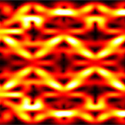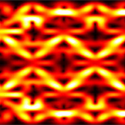Tunable gaps in strained graphene
Since its discovery, graphene’s potential in electronics has been clouded by the absence of a fundamental energy gap in its electronic structure. There have been several proposals to open and tune the gap, however, they all have a detrimental effect on electron mobility, and graphene’s high electron mobility is what makes it so attractive for electronics in the first place.
In an article in Physical Review B, Tony Low at IBM T. J. Watson Research Center, US, and co-workers in the US, Spain, and the Netherlands propose a novel way to open the gap in graphene. Low et al. show that a proper combination of gauge (e.g., long-wavelength strain) and scalar fields (e.g., electrostatic potential) creates a Haldane state—a quantum Hall insulator without a macroscopic magnetic field—that is characterized by a bulk gap and gapless edge states, which are valley-polarized in the current case. Such a situation can occur in graphene a number of ways: naturally, or due to correlations between a periodic substrate and graphene, or it can be engineered in a controlled manner using electrostatic gates. More importantly for applications, in this way, the gap is induced without increasing the amount of scattering in the system, thus preserving the most valued property of graphene. – Athanasios Chantis





